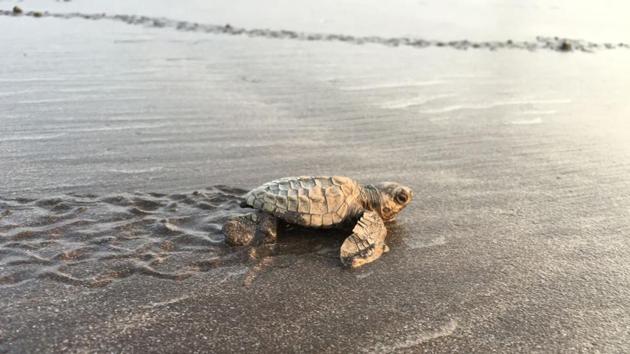After Odisha, Maharashtra to study Olive Ridley turtle’s migratory route
In a first for Maharashtra and the west coast, Olive Ridley turtles at various beaches at Ratnagiri will be tagged to understand their migratory pattern.
In a first for Maharashtra and the west coast, Olive Ridley turtles at various beaches at Ratnagiri will be tagged to understand their migratory pattern. Maharashtra will be the second state in India, after Odisha, to understand their breeding pattern and movement.

In a joint effort by state forest department and mangrove cell, the tagging process will commence during winter. Currently, forest officials from Odisha will begin training their counterparts in Maharashtra.
Olive Ridleys are endangered sea turtles found in warm tropical parts of the Indian and Pacific oceans. They travel thousands of kilometres into the ocean and only the females return to the original breeding sites within a minimum of two years.
“Olive Ridley turtles have never been tagged along the western coast of India. We would like to study where these animals are moving, whether towards the Middle East, Pakistan or even southwards to Sri Lanka and understand their migratory pattern,” said N Vasudevan, chief conservator of forest, state mangrove cell.
According to the mangrove cell, approximately 600 Olive Ridley turtles find their way to nesting sites across various districts of Maharashtra including some of the prominent beaches like – Velas, Anjarle, Harihareshwar, Maral and Diveagar beaches in Ratnagiri every year.
“Tracing individual turtles using their limb marks are very difficult but once the tagging process will start we will be able to identify them individually,” said Suresh Warak, range forest officer, Dapoli. “The issue of climate change combined with overfishing is reducing their population and the tagging process will allow us to safeguard the species much better.”
While turtles have been spotted at nesting sites along 10 beaches at Dapoli, Ratnagiri, 12 along Sindhudurg and 10 beaches in Raigad districts for nesting purposes this year, only 10% have finished laying their eggs and moved into the sea, said forest officials. “Owing to hardly any scientific studies in the field, the impact of climate change needs to be studied. However, there have been no deaths recorded from famous turtle nesting beaches this year,” said Vasudevan.
The tagging project is under the Deutsche Gesellschaft für Internationale Zusammenarbeit (GIZ), an international agency under the Coastal Marine Protected Areas (CMPA) project along with the mangrove cell. “The advantages of such a project will be seen on an annual basis. We will be able to say how many years it takes for a female to come back to the same beach or neighbouring beaches,” said Mohan Upadhyay, project associate, CMPA Dapoli. “It is a belief that turtles along the west coast do not migrate but there is no scientific data to prove it. By this year end, we will be able to start gene-based studies and confirm their migratory pattern.”
READ MORE
In pics | Awed by nature: Olive ridley turtles return to Odisha’s beaches for laying eggs



